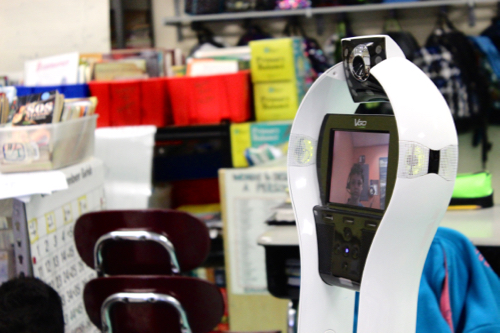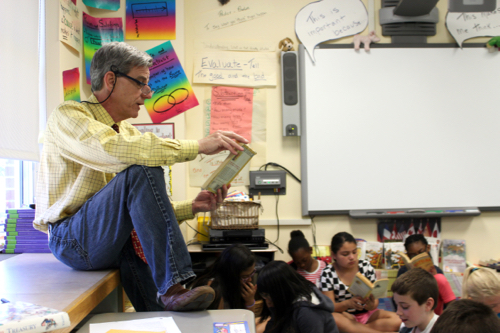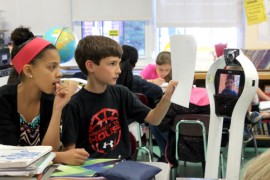In a colorful Aquebogue Elementary School classroom, fourth graders have broken into small clusters of desks to discuss a chapter from the book Matilda.
“Gabriel, these are the questions we’re working on,” says one boy, who is sitting next to a sleek robotic device that rises about four feet off the ground. “Do you have them?”
The device turns on its wheels to face him, and an 8-year-old boy with dark curls and a big smile peers out of its screen, examining his friend’s packet.
“Yes, I’ve got them,” Gabriel chimes through the robot’s speakers.
Gabriel Dispenziere has never been able to attend school because of a rare allergic condition that prevents him from eating any food – a condition so severe that he can’t even be near food, or people who might have food on their hands or breath.
But since he moved to Riverhead from California last May, Gabriel has been able to attend class for the first time ever – initially using an iPad, and now through far more sophisticated robotic equipment that he can control right from home.

When we first wrote about Gabriel in March, he was using a video calling application to connect with an iPad in his classroom, which his teacher would wheel around on a rolling stand.
Since then, the school has installed a robotic device that allows Gabriel to move around the classroom all on his own.
The vGo robot is a slender, elegant device on wheels. It’s part of an emerging new form of robotic technology that specializes in telepresence, which allows users to act and feel as though they are someplace they are not.
In Gabriel’s case, this place is Robert Shilling’s fourth grade classroom.
Though the vGo was initially designed to be used in healthcare and business settings, it has found major success helping kids who, usually for health reasons, can’t physically attend class.
“It’s such a difference for him to be able to turn and move,” said Raquel Dispenziere, Gabriel’s mother. “Trying to watch class from a stationary point, when he was only looking through the iPad, he couldn’t look around the room. Now, he can drive around the class, he can turn the screen so he can see the kid next to him – it’s little things like that that make all the difference.”

Dispenziere first learned about the vGo when she was looking into ways for Gabriel to attend class in California. But the school district there was resistant to her attempts to get Gabriel in the classroom through an iPad, never mind a robot.
That changed when they moved to Riverhead, she says. Not only did Riverhead’s special education department make sure Gabriel was able to attend school that September with the iPad, but the department worked quickly with Eastern Suffolk BOCES to get a vGo in the classroom for Gabriel this spring.
“There was no hesitation,” Dispenziere said. “Everybody was all for it. They wanted to get it done as quickly as possible.”
It only took a week to get the robot installed in Aquebogue.
“Mr. Shilling wanted to surprise him,” Dispenziere said. “So we installed an app on Gabriel’s iPad where he can control the vGo. And that morning, I walked to his room with his iPad, and I told him that we wouldn’t be able to video call with the class anymore.
“I really thought he was going to cry,” she said. “He was so sad.”
But after Gabriel opened his iPad and saw the words “vGo,” she said, his face completely lit up.
“I cried all day long,” she said. “He was so thrilled. He was just so excited.”
WATCH: Gabriel’s reaction when he finds out about the vGo
Every day, around 9:30 in the morning, the vGo whirs to life in the corner of the classroom and Gabriel’s face pops up on the screen. He is greeted with a chorus of “Hi, Gabriel!” from his classmates as the robot glides across the classroom floor.
Gabriel has his own desk, with his name written in cursive on a sticker. If he wants to answer a question, instead of raising his hand, he can flash a light on the vGo to get the teacher’s attention.
He does this all with an iPad in a room miles away, safe from the food allergens that would threaten his life in a classroom full of snacks and lunch boxes. He uses his iPad to control the robot’s motions and camera, with a live video stream of the classroom on screen.
Shilling takes pictures of the day’s worksheets and messages them to Gabriel. If the class is working on a science experiment, Shilling will even drop the materials off at his house beforehand so that Gabriel can follow along with his classmates later that day.

“I look at him as a regular student in my class,” Shilling said in an interview. “My expectations from him are academically the same as anybody. In fact, he’s a very bright boy, so the expectations for him might be a little bumped up.”
The vGo not only has made Gabriel’s classroom experience more immersive, but it has also allowed him to participate in activities he has never before been able to experience.
For example, Gabriel has been able to attend music classes for the first time. Tonight, he will be performing through the vGo’s speakers in his first chorus concert, with his mom watching in the audience.
It has also allowed Gabriel to get to know the school a little better.

“There was story-time going on in the library, so Gabriel went down the hallway for the first time,” Dispenziere said. “And afterward he told me, ‘Mom, the library is WAY on the other side of the school! And there were a couple of stairs, but that’s okay, because Mr. Shilling carried me.’
“And just the way he said – Mr. Shilling carried me, and not ‘the vGo’… He refers to it as himself,” Dispenziere said, a little tearfully. “It has made such a difference for him.”
Having a physical presence through the vGo has made Gabriel feel like he’s truly part of the class, she added. The first day that the vGo was in the classroom, Shilling told Gabriel that he didn’t have to sign off during lunchtime as he usually did. “I’m going to have my lunch in here,” Shilling told the class. “If anyone wants to eat here and just hang out with Gabriel, you can.”
“And the entire class stayed in,” Dispenziere said. “It was so sweet. Gabriel was like, ‘Mom, they all stayed in during lunch to play with me. Just for me.’”
“The social aspect alone seems worth it,” Shilling said. “It’s sad to think about how if he didn’t have this, he really wouldn’t interacting with all that many kids.”
Gabriel will move on to fifth grade this fall at Pulaski Street School, which means a new teacher, a new classroom and new technological hurdles to overcome. But Shilling says the staff at Pulaski is already preparing for Gabriel’s arrival, and that the district’s technology department is already learning from issues that have cropped up at Aquebogue to make the wireless environment at Pulaski suitable for Gabriel’s robot.
“Gabriel is just such an amazing kid,” Shilling said. “I can’t believe all the things he has to deal with on a daily basis that all of us take for granted. We’re just trying to provide him with the educational experience that he deserves.”
The survival of local journalism depends on your support.
We are a small family-owned operation. You rely on us to stay informed, and we depend on you to make our work possible. Just a few dollars can help us continue to bring this important service to our community.
Support RiverheadLOCAL today.































